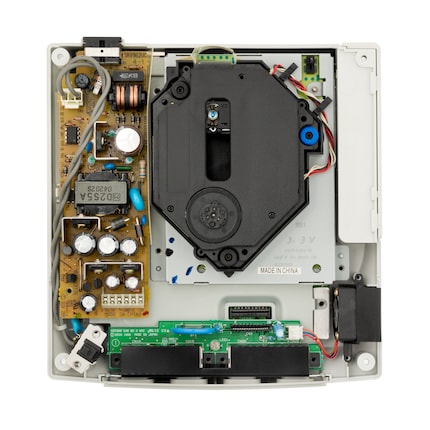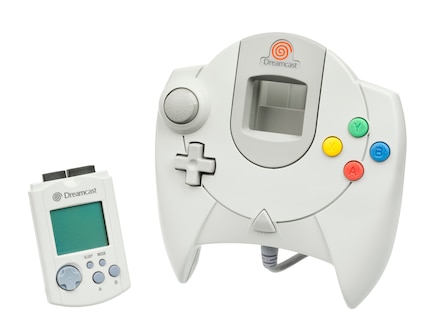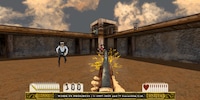
Background information
How Sony revolutionised the console market with the PlayStation
by Kevin Hofer

Twenty-five years ago, Sega’s last game console hit the shelves in Europe. The Dreamcast was in production for just two and a half years. Today, however, it has cult status.
Years before the Wii Remote, you could swoosh a motion-sensor racket through the air in Virtua Tennis. Sure, the fishing rod controller didn’t exactly make for ideal tennis equipment. After all, it was developed for Sega Bass Fishing. But it worked.
The maraca controllers for Samba de Amigo (1999) were bizarre too. As was Sega’s experiment with the Visual Memory Unit, a memory card with a built-in screen you could use to play simple games. The Dreamcast boasted a variety of quirky hardware and game ideas. That’s probably why it’s still extremely popular with fans like me today.
In late autumn 1998, Sega launched the Dreamcast in Japan. Technologically, it was ahead of its time, even sporting a modem for online gaming. The 128-bit console was kitted out with a 200 MHz Hitachi CPU, 16 megabytes of RAM and a 100 MHz 3D Video Logic graphics chip. Plus, the specially developed GD-ROM optical storage medium boasted 1.2 gigabytes of space. With its new console, Sega, already in crisis at this point, appeared to be ready to compete with the upcoming PlayStation 2.
I couldn’t wait for it to come out. Although I was a PlayStation guy, the Dreamcast simply looked too cool. For a games fanatic like me, the option of gaming on the Virtual Memory Unit was a bonus. The titles announced for release (most notably Shenmue) also helped convince me to switch to the Dreamcast camp.

In the nineties, a console war was raging between Sony, Nintendo and Sega. Sony and Nintendo were dominating, with Sonic Group lagging behind in third place. But it never should’ve come to that. Years before, Sony had been looking for a partner to help it get into the console market. However, it was turned down by both Sega and Nintendo. As a result, Sony developed the PlayStation off its own back, mercilessly blowing the Saturn (Sega’s answer to the PS1) out of the water. With this in mind, the Dreamcast was essentially Sega’s last chance.

But the console was up against some bad omens from the very beginning. Only 150,000 units were available for the Japanese launch, which wasn’t enough. Sega scared away potential customers with the mistake. All the more so given the at-launch game line-up consisted of a modest four titles. There wasn’t much incentive to rush out and buy the console. Just a few months after launch, Sega cut the price by around 30 per cent. After that, it was barely making a profit.
Sega ended up taking the lower-priced console to the USA and Europe, where it went down well. Sales were strong, partly because the games line-up had been significantly expanded since the Japanese launch. Soul Calibur and Sonic Adventure proved compelling reasons to buy the console. Sega also snagged a brilliant exclusive title: Resident Evil: Code Veronica. Experimental games such as Crazy Taxi and Jet Set Radio were also well received.
I got the console as soon as it was released in Switzerland. Thankfully, I didn’t need to queue outside a store before opening time. Instead, I reserved one from a retailer. I still remember unboxing the Dreamcast and being amazed at how small and light it was. My first game was Sonic Adventure. Although I enjoyed it, the anticipation of playing other titles was too great for me to spend time playing that game for long. It took me a few months to really warm up to my Dreamcast.
Viewed from the outside, everything seemed to be going well at Sega. Behind the scenes, however, things were reaching boiling point. Squaresoft (now Square), a key player Japan, wouldn’t publish any games for the console. Meanwhile, Electronic Arts didn’t want any competition for sports games on consoles. When Sega announced that it would start manufacturing its own sports games, EA got in the way and shunned the Dreamcast.
The much bigger problem for Sega, however, was Sony. The PlayStation 2 was announced in March 1999 – before the Dreamcast came on the scene in the US and Europe. Packing more power than the Sega console, the PS2 also had the edge on GD-ROMs with its built-in DVD drive. This meant it could play films – a novelty at the time. When the DVD market subsequently exploded, the PlayStation 2 reaped the benefits.
I didn’t fully get into my Dreamcast until the PlayStation 2 came out. About a year after I first got my hands on the console, I finally had a bounty of games at my fingertips. Smash hit Shenmue was about to be released. A few months later, the first-class JRPGs Skies of Arcadia and Grandia II came out. Even so, I was still eyeing up PlayStation 2s. As a movie buff, the DVD drive was just too tempting for me. Feeling bad at the thought of ditching the Dreamcast, I opted to ignore the PS2 for the time being.
But neither my loyalty nor Sega’s online offensive with Phantasy Star Online and the SegaNet service could save the Dreamcast. Just one year after the PS2’s Japanese launch, Sega discontinued the Dreamcast and left the console business. Still, at least it stuck around to develop games for its former competitors.
But even today, the Dreamcast isn’t completely dead. Fans are still developing new games under the name «Dreamcast homebrew».
I have really fond memories of the Dreamcast. It was the last games console I had throughout its entire life cycle. I’ve owned many consoles since then, but only ever at the very beginning or very end of their lifespans. That’s why the Dreamcast will always have a special place in my heart.
From big data to big brother, Cyborgs to Sci-Fi. All aspects of technology and society fascinate me.
Interesting facts about products, behind-the-scenes looks at manufacturers and deep-dives on interesting people.
Show all
Background information
by Kevin Hofer

Background information
by Philipp Rüegg

Background information
by Philipp Rüegg